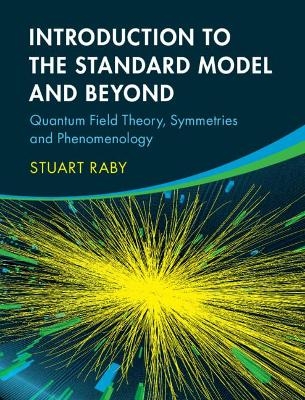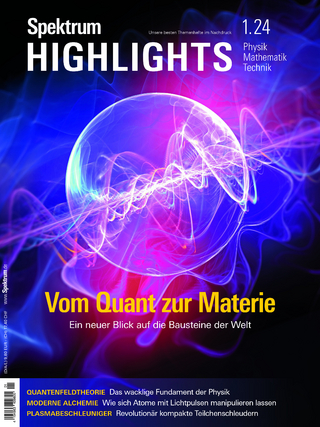
Introduction to the Standard Model and Beyond
Cambridge University Press (Verlag)
978-1-108-49419-9 (ISBN)
The Standard Model of particle physics is an amazingly successful theory describing the fundamental particles and forces of nature. This text, written for a two-semester graduate course on the Standard Model, develops a practical understanding of the theoretical concepts it's built upon, to prepare students to enter research. The author takes a historical approach to demonstrate to students the process of discovery which is often overlooked in other textbooks, presenting quantum field theory and symmetries as the necessary tools for describing and understanding the Standard Model. He develops these tools using a basic understanding of quantum mechanics and classical field theory, such as Maxwell's electrodynamics, before discussing the important role that Noether's theorem and conserved charges play in the theory. Worked examples feature throughout the text, while homework exercises are included for the first five parts, with solutions available online for instructors. Inspired by the author's own teaching experience, suggestions for independent research topics have been provided for the second-half of the course, which students can then present to the rest of the class.
Stuart Raby is a professor of physics at The Ohio State University. He is among the original proponents of the supersymmetric extension of the Standard Model and a pioneer of supersymmetric grand unified theories. His work focuses on the experimental consequences of physics beyond the Standard Model, ranging from collider experiments to proton decay searches, dark matter candidates and questions in cosmology. His first book, Supersymmetric Grand Unified Theories, was published in 2017.
Part I. Getting Started: 1. Notation; Part II. Symmetries and Quantum Field Theory: 2. Poincare Invariance; 3. Spin; 4. Completeness and Normalization; 5. Quantum Mechanics; 6. Unitarity and Partial Waves; 7. Introduction to Field Theory; 8. Complex Scalar Field; 9. Spin 1/2 Particles; 10. Weyl Spinors; 11. Spin 1 Particles; 12. The S Matrix in Field Theory; Part III. Quantum Electrodynamics: 13. QED; 14. Magnetic Moments in QED; 15. The Size of the Proton; Part IV. Discrete Symmetries and their Consequences: 16. Charge Conjugation and Parity; 17. Time Reversal Invariance; 18. CPT Theorem; Part V. Flavor Symmetries: 19. Global Symmetries; 20. Testing Isospin and G Parity; 21. Evidence for New Particles, Quantum Numbers and Interactions; 22. Representation Theory for SU(2); 23. SU(3) Symmetry; 24. Tests of SU(3) Symmetry; Part VI. Spontaneous Symmetry Breaking: 25. Spontaneous Symmetry Breaking; 26. Spontaneous Symmetry Breaking in Hadronic Physics; 27. Current Algebra and the Adler-Weisberger relation; Part VII. Road to the Standard Model: QCD: 28. QCD; 29. Quantizing Non-Abelian Gauge Theory; 30. Renormalization; 31. Deep Inelastic e − N Scattering; 32. LHC Physics and Parton Distribution Functions; Part VIII. Road to the SM: Electroweak Theory: 33. The Electroweak Theory; 34. Electroweak Symmetry Breaking; 35. Electroweak Phenomenon; 36. Deep Inelastic Scattering Revisited; 37. Weak Interactions of Quarks; Part IX. The Standard Model: 38. Three Family Model; 39. Determining VCKM and Quark Masses; 40. CP violating parameters ϵK and ϵ′K; 41. Effective Field Theories; 42. Anomalies; Part X. Neutrino Oscillations: 43. Neutrino Oscillations: Atmospheric; 44. Neutrino Oscillations: Solar; 45. Neutrino Oscillations Continued: Neutrino Mass and Mixing Angles; Part XI. Grand Unification: 46. Grand Unification; 47. Supersymmetry; 48. Superfields; 49. SUSY SU(5); Part XII. Minimal Supersymmetric Standard Model: 50. Supersymmetric Standard Model; 51. Spontaneous SUSY Breaking; 52. MSSM Phenomenology; Part XIII. Second Semester Projects: 53. Suggested Term Projects 1; 54. Suggested Term Projects 2; Part XIV. Appendices: Appendix A: Gell-Mann-Low Theorem; Appendix B: Wick's Theorem; Appendix C: One Loop Calculations in QED; Appendix D: Renormalization in QED; Appendix E: Triangle Anomaly.
| Erscheinungsdatum | 02.08.2021 |
|---|---|
| Zusatzinfo | Worked examples or Exercises |
| Verlagsort | Cambridge |
| Sprache | englisch |
| Maße | 193 x 252 mm |
| Gewicht | 1550 g |
| Themenwelt | Naturwissenschaften ► Physik / Astronomie ► Hochenergiephysik / Teilchenphysik |
| ISBN-10 | 1-108-49419-6 / 1108494196 |
| ISBN-13 | 978-1-108-49419-9 / 9781108494199 |
| Zustand | Neuware |
| Haben Sie eine Frage zum Produkt? |
aus dem Bereich


